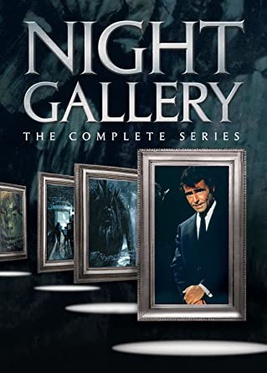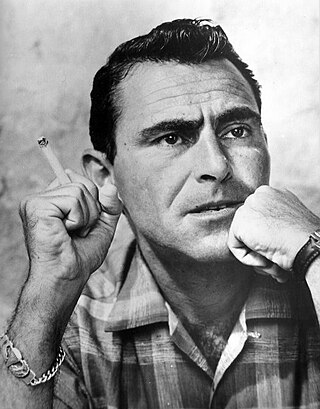Related Research Articles

The Twilight Zone is an American media franchise based on the anthology television series created by Rod Serling in which characters find themselves dealing with often disturbing or unusual events, an experience described as entering "the Twilight Zone". The episodes are in various genres, including fantasy, science fiction, absurdism, dystopian fiction, suspense, horror, supernatural drama, black comedy, and psychological thriller, frequently concluding with a macabre or unexpected twist, and usually with a moral. A popular and critical success, it introduced many Americans to common science fiction and fantasy tropes. The first series, shot entirely in black-and-white, ran on CBS for five seasons from 1959 to 1964.

Night Gallery is an American anthology television series that aired on NBC from December 16, 1970, to May 27, 1973, featuring stories of horror and the macabre. Rod Serling, who had gained fame from an earlier series, The Twilight Zone, served both as the on-air host of Night Gallery and as a major contributor of scripts, although he did not have the same control of content and tone as he had on The Twilight Zone. Serling viewed Night Gallery as a logical extension of The Twilight Zone, but while both series shared an interest in thought-provoking dark fantasy, more of Zone's offerings were science fiction while Night Gallery focused on horrors of the supernatural.

Rodman Edward Serling was an American screenwriter and television producer best known for his live television dramas of the 1950s and his anthology television series The Twilight Zone. Serling was active in politics, both on and off the screen, and helped form television industry standards. He was known as the "angry young man" of Hollywood, clashing with television executives and sponsors over a wide range of issues, including censorship, racism, and war.

"Where Is Everybody?" is the first episode of the American anthology television series The Twilight Zone and was originally broadcast on 2 October 1959, on CBS. It is one of the most realistic Twilight Zone episodes, as it features no supernatural elements and is based on fairly straightforward extrapolation of science.

"Time Enough at Last" is the eighth episode of the American anthology series The Twilight Zone, first airing on November 20, 1959. The episode was adapted from a short story by Lynn Venable, which appeared in the January 1953 edition of If: Worlds of Science Fiction.

"Mirror Image" is the twenty-first episode of the American television anthology series The Twilight Zone. It originally aired on February 26, 1960, on CBS.
"Nightmare as a Child" is episode 29 of the American television anthology series The Twilight Zone. It originally aired on April 29, 1960, on CBS.
"The Night of the Meek" is episode 47 of the American television anthology series The Twilight Zone. It originally aired on December 23, 1960, on CBS. It was one of the six episodes of the second season which were shot on videotape in a short-lived experiment aimed to cut costs.
"It's a Good Life" is the eighth episode of the third season of the American television series The Twilight Zone, and the 73rd overall. It was written by series creator/showrunner Rod Serling, based on the 1953 short story "It's a Good Life" by Jerome Bixby. The episode was directed by James Sheldon, and is considered by some, such as Time and TV Guide, to be one of the best episodes of the series. It originally aired on November 3, 1961. The episode was one of four from the original 1959 series which formed the basis of the 1983 film Twilight Zone: The Movie.

Richard Lewis Deacon was an American television and motion picture actor, best known for playing supporting roles in television shows such as The Dick Van Dyke Show, Leave It to Beaver, and The Jack Benny Program, along with minor roles in films such as Invasion of the Body Snatchers (1956) and Alfred Hitchcock's The Birds (1963).

"The Last Night of a Jockey" is an episode of the American television anthology series The Twilight Zone. In this episode, a diminutive jockey's wish to be a big man is granted. Rod Serling wrote the episode specifically for Mickey Rooney, who is the only actor to appear in it.

"In Praise of Pip" is an episode of the American television anthology series The Twilight Zone. In this episode, after learning that his soldier son has suffered a mortal wound in an early phase of the Vietnam War, a crooked bookie encounters a childhood version of his son.
"Probe 7, Over and Out" is an episode of the American television anthology series The Twilight Zone. Its plot is a shaggy God story.

The Twilight Zone is an American fantasy science fiction horror anthology television series created and presented by Rod Serling, which ran for five seasons on CBS from October 2, 1959, to June 19, 1964. Each episode presents a standalone story in which characters find themselves dealing with often disturbing or unusual events, an experience described as entering "the Twilight Zone", often with a surprise ending and a moral. Although often considered predominantly science-fiction, the show's paranormal and Kafkaesque events leaned the show much closer to fantasy and horror. The phrase "twilight zone", inspired by the series, is used to describe surreal experiences.
"I Sing the Body Electric" is episode 100 of the American television anthology series The Twilight Zone. The 1962 script was written by Ray Bradbury, and became the basis for his 1969 short story of the same name, itself named after an 1855 Walt Whitman poem. Although Bradbury contributed several scripts to The Twilight Zone, this was the only one produced.
"The Long Morrow" is episode 135 of the American television anthology series The Twilight Zone. It originally aired on January 10, 1964 on CBS. In this episode, an astronaut falls in love on the eve of a 40-year-long space voyage. The story focuses on how he and his lover confront the problem that his 40 years in suspended animation will cause a wide age disparity between them by the time he returns.
"Come Wander with Me" is the final episode to be filmed of the American television series The Twilight Zone. This episode introduced Bonnie Beecher in her television debut.
Recreation Park is a public, urban park in Binghamton, New York. Located in Binghamton's West Side, Recreation Park is bordered by Schubert Street to the North, and Laurel Avenue to the East, Seminary Avenue to the South, and Beethoven Street to the West. Shoe manufacturer George F. Johnson donated it to Binghamton, and it is home to one of Allan Herschell's six famous carousels. The park also contains a bandstand, statues and monuments, numerous athletic fields and courts, swimming facilities, a playground, and walking paths in a grove of mature oak trees.

The George F. Johnson Recreation Park Carousel is a historic carousel located at Binghamton in Broome County, New York. The carousel and its pavilion were built in 1925. The carousel is housed in a wooden, one story, 16-sided, pavilion topped by a cupola. The carousel has 60 horses standing four abreast, each of which is a "jumper," and two chariots. It was constructed by the Allan Herschell Company and contains its original Wurlitzer Military Band Organ. The carousel was listed on the National Register of Historic Places in 1992.
There are a number of notable sources of media in Binghamton, New York. Located near the border with Pennsylvania, Binghamton media act as a source of information and entertainment for a large region, extending well beyond the metropolitan area. Most local television and radio stations broadcast from Ingraham Hill, which is located in the town of Binghamton, just south of the city.
References
- 1 2 "Top 10 Twilight Zone Episodes". Time. October 2, 2009. Archived from the original on October 8, 2009. Retrieved May 11, 2011.
- ↑ Rod Serling official website
- ↑ "Rod Serling's favorite Twilight Zone episodes were personal stories". www.syfy.com. Archived from the original on November 14, 2019.